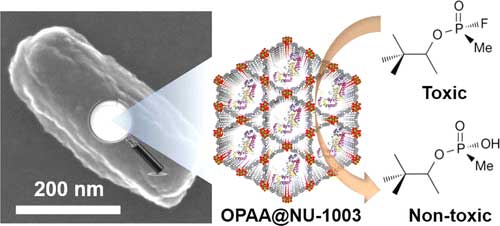| Posted: Oct 05, 2016 |
A nerve agent antidote that could be taken before an attack
(Nanowerk News) Nerve agents are molecular weapons that invade the body and sabotage part of the nervous system, causing horrific symptoms and sometimes death within minutes. Few antidotes exist, and those that do must be administered soon after an attack. But now scientists report in the journal ACS Nano ("Nanosizing a Metal–Organic Framework Enzyme Carrier for Accelerating Nerve Agent Hydrolysis") an early-stage development of a potential treatment that soldiers or others could take before such agents are unleashed.
|
 |
| Synthesis and characterization of a water-stable zirconium metal–organic framework (MOF), NU-1003, featuring the largest mesoporous aperture known for a zirconium MOF. This material has been used to immobilize the nerve agent hydrolyzing enzyme, organophosphorus acid anhydrolase (OPAA).
|
|
One particular antidote, an enzyme called organophosphorus acid anhydrolase (OPAA), has attracted attention recently for its ability to break down nerve agents. But the body's immune system gets rid of it quickly. Packaging the enzyme in liposome nanocarriers gives the antidote greater staying power, but handling and storing the liposomes is complicated. So Omar K. Farha and colleagues wanted to make a potentially simpler carrier.
|
|
For a material, the researchers turned to porous metal-organic frameworks (MOFs), a class of hybrid materials made of metallic ions and organic ligands that are easy to store and handle at room temperature. They used a zirconium-based MOF and loaded it with the antidote. Testing showed the MOF-encapsulated enzyme was even more effective at breaking down the nerve agent simulant diisopropyl fluorophosphate and the nerve agent soman than the antidote by itself.
|

